
 an edible plant or part of a plant other than a fruit. USDA organizes vegetables into 5 subgroups, based on their nutrient content: Dark Green Vegetables (bok choy, broccoli, collard greens, dark green leafy lettuce, kale, mesclun, mustard greens, romaine lettuce, spinach, turnip greens, watercress); Red and Orange Vegetables (acorn squash, butternut squash, carrots, hubbard squash, pumpkin, red peppers, sweet potatoes, tomatoes, tomato juice); Starchy Vegetables (cassava, corn, fresh cowpeas, field peas, or fresh black-eyed peas, green bananas, green peas, green lima beans, plantains, potatoes, taro, water chestnuts); Beans and Peas (dry beans, chickpeas and split peas) and Other Vegetables - like avocado or iceberg lettuce.
Comments
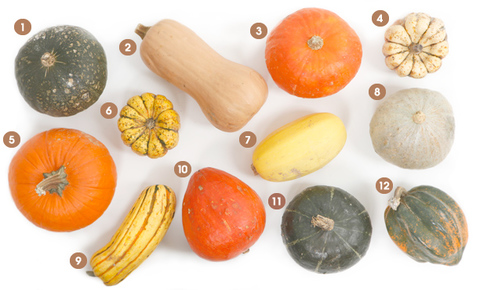 Eaten as a vegetable, winter squash is a fruit with a hard rind, harvested in autumn and stored through much of winter. It comes in diverse forms and colors that could be used to brighten dishes. Flavors are generally mild-to-sweet, so squash won't overwhelm other ingredients and can easily be incorporated into many dishes. The winter squash family is naturally low in fat and calories, and delivers significant nutritional benefits. For example, one cup of baked butternut squash is rich in vitamins A (from beta carotene), B6, C, and E, as well as magnesium, potassium, and manganese. Butternut Squash has a relatively sweet taste. Kabocha Squash (1, 3) has a nutty, earthy flavor with just a touch of sweetness. Green kabocha is relatively savory, the red kabocha but is much sweeter. Carnival Squash (4) resembles Acorn squash (12) and sweet dumpling squash (6) and has a mellow and sweet yellow flesh. Sugar (pie) pumpkin (5) has a classic pumpkin flavor. Sweet dumpling squash (6) and Delicata Squash (9) both taste like sweet potato. Spaghetti Squash is mild-tasting. Blue Hubbard Squash ha gray-blue skin and sweet-tasting orange flesh. Red Kuri Squash (10) has a chestnut-like flavor. Buttercup squash (11) is very mil in taste. Acorn Squash (12) is mildly flavored and is better eaten green - it can be too tough and fibrous when turned orange. Butternut Squash (2) has a bright orange slightly sweet flesh high in potassium, especially if eaten raw (grated or thinly sliced into salads or coleslaws). 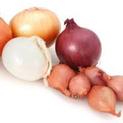 aromatic flavorful vegetable with succulent/fleshy, tight, concentric leaf bases having a pungent odor. Enlarged base (bulb) of a plant, Allium cepa, species of the Allium family that also includes garlic (Allium sativum). Common onions are normally available in three yellow, brown, red, purple and white colors.. Yellow or brown onions (also called red) are full-flavored and are the onions of choice for everyday use. Yellow onions turn a rich, dark brown when caramelized and give French onion soup its sweet flavor. The red onion (also called purple) is a good choice for fresh use but can be also good for grilling. White onions are widely used in classic Mexican cuisine, and have a particularly sweet flavor when sauteed. 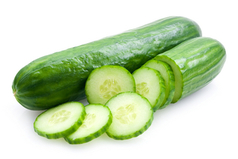 Fruit of Cucumis sativus, a widely cultivated plant in the gourd family Cucurbitaceae, which includes squash, and in the same genus as the muskmelon. Usually eaten raw in unripe green form, as a vegetable. Majority of people describe the taste as mild, light melon-like and almost watery while a small minority think it's repugnant and perfume-like. Can be used in salads, appetizers, sauces, sandwiches, cocktails, cold soups and stir fry. Has many health benefits (due to high content of minerals) and cosmetic properties (due to its cooling and cleansing effect). one medium cucumber contains 1.25 cup of water, 12% daily value of potassium, 14% of vitamin C, 9% of Magnesium, 0.4g of flavonoid Kaempferol. 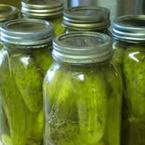 small cucumbers (about 4oz, 7 cubic inches, 70 grams each) preserved in vinegar, brine, or a similar solution. Popular snacks or side dishes. Good source of fiber and magnesium that aid digestion and spices such as turmeric that may be able to prevent the onset of Alzheimer's disease. Lacto-fermented pickles are also rich in probiotics and live enzymes. Fermented pickles (also called brined pickles and dill pickles) are prepared by soaking cucumbers in brine for several weeks. During this period, lactic acid bacteria that are salt tolerant, produce lactic acid from natural sugars in cucumbers (as the salt leaches sugars out from the cucumbers). A succession of microbes is involved. Streptococci start the process, producing acid. As the pH falls, types of Leuconostoc, Pediococcus and Lactobacillus grow, making more acid. Fresh-pack pickles are not fermented. hey are are prepared by soaking cucumbers in brine, then drained and covered with a boiling hot pickling solution containing vinegar and spices. Excessive consumption could increase blood pressure because of high sodium content, cause bloating and diarrhea. 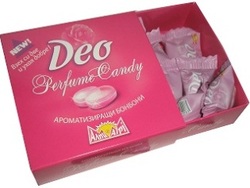 Deo Perfume Candy is marketed as a functional food that leaves your skin with a beautiful rose fragrance. The claims are based on research published in 2006, showing that ingested rose oil makes our palms to exude smell like aromatic compounds, such as Geraniol, through the skin. The strength and duration of the rose fragrance is said to depend upon body weight. Anecdotal evidence, however, does not point to a noticeable pleasant smell after eating the candy. The ingredients in Deo Perfume Candy are sugar, glucose syrup, citric acid, malic acid, geraniol (12 mg per serving - 4 pieces of candy), rose oil, carmine and natural tangerine flavor. The sugar-free version of Deo Perfume Candy contains Isomalt (a sugar substitute), acesulfame potassium, citric acid, malic acid, geraniol, rose oil and natural tangerine flavor. The rose oil used in Deo Perfume Candy is an essential oil extracted from Rosa damascena, a species of rose harvested by hand in Bulgaria. Two thousand petals are needed to create a single gram of rose oil. Not for people with perfume allergies and chemical sensitivities. |
Categories
All
|
